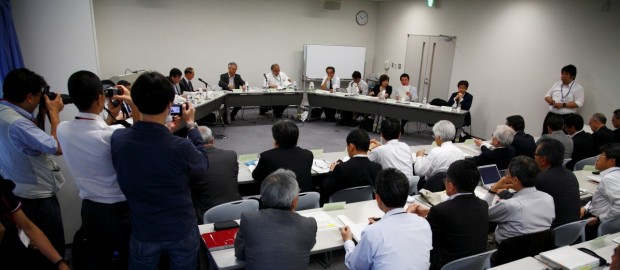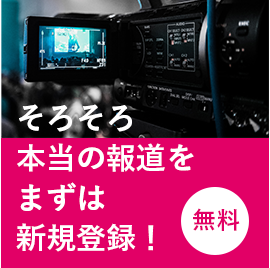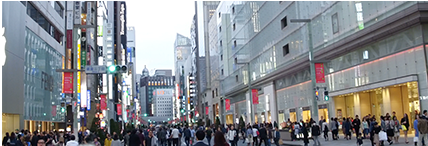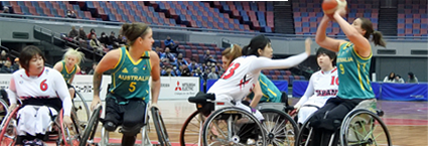Have Cases of Thyroid Cancer in Fukushima Nothing to Do with Radiation? By RYUICHI KINO
June 11, 2013
Ryuichi Kino was born in 1966. He became a freelance writer in 1995 after a carrier in production editing. He wrote the book “Kensho, Fukushima Genpatsu Jiko Kaiken, Toden/Seifu wa Nani wo Kakushita no ka (Iwanami Shoten)” (What Did TEPCO and the Government Conceal about the Fukushima Nuclear Accident?) Official Blog: “Kino Ryu ga Kaku”: http://kinoryu.cocolog-nifty.com/
On June 5 at 10:15 a.m., with a 15-min. delay, the Fukushima Prefecture panel investigating on the impact of radiation on residents’ health (with Hokuto Hoshi as Chairman) started its evaluation meeting. Discussions were focused on thyroid cancer screening results, despite a host of other issues on the agenda, i.e. the health examination conditions and the problematic Basic Survey whose response rates continue to show the stagnant figure of roughly 23%.
Shinichi Suzuki, professor at Fukushima Medical University and a member of the prefectural panel reported that the number of persons with or suspected of developing thyroid cancer lumps has increased to a total of 28. He instructed that surgery be conducted on 13 cases. A post-surgery pathological examination has revealed that one person had only a benign tumor. The remaining 12 cases developed a papillary thyroid cancer. At the previous evaluation meeting, it was announced that only 10 people developed or were suspected of developing a malignant tumor. After surgery 3 were confirmed to have thyroid cancer.
Outline of Thyroid Cancer Screening Results by the Fukushima Health Management Survey Panel
Excerpt from:
http://www.pref.fukushima.jp/imu/kenkoukanri/250605siryou2.pdf
Results reported at previous evaluation meetings have already received large media coverage. Thyroid cancer screening results drew diverse responses from the media. The national and the Fukushima editions of the Asahi Shimbun, for instance, projected different perspectives.
Radiation Effect Denied: 12 Cases of Thyroid Cancer Confirmed (Fukushima Minpo, June 6, 2013)
http://www.minpo.jp/news/detail/201306068849
Minors between 8 and 18 Years of Age: Target of the Prefectural “Thyroid Cancer Screening” Panel (Fukushima Minyu, June 6, 2013)
http://www.minyu-net.com/news/news/0606/news9.html
12 Fukushima Children with Thyroid Cancer, Prefectural Panel Dismisses Radiation Effect (Asahi Shimbun, June 5, 2013)
http://www.asahi.com/area/fukushima/articles/MTW1306050700007.html
12 Children with Thyroid Cancer, Health Study Panel Recommends a “Long-term Observation” (The Fukushima edition of the Asahi Shimbun, June 6, 2013)
http://www.asahi.com/area/fukushima/articles/MTW1306050700007.html
Curious Incidence of “12 Infant Thyroid Cancer Cases in Fukushima” (Toyo Keizai Online, June 9, 2013)
http://toyokeizai.net/articles/-/14243?page=2
So far, Professor Suzuki has maintained that on average just one or two in a million of children contract thyroid cancer. On March 3, 2012, the online version of the Nagasaki Shimbun reported that Professor Suzuki indicated that ongoing serious medical examinations might lead to diagnoses of micro cancers regardless to the effect of radiation exposure, which is likely to increase the percentage of cancer cases.
1st Anniversary of the Great East Japan Catastrophe: Low-Level Radioactive Contamination/Infant Thyroid Cancer, Nagasaki University/Fukushima 2 (Nagasaki Shimbun, March 5, 2012)
http://www.nagasaki-np.co.jp/news/k-peace/2012/03/05165027.shtml
In the document “Research Background and Purpose” submitted to the Ethical Committee of Fukushima Medical University, upon mentioning that “regardless to radiation exposure, on average 0.1~1% and plus respectively through ordinary palpation tests and ultrasound diagnoses, thyroid cancer might be detected”, Professor Suzuki’s team gave the following observations.
- However, only one or two children in a million contract thyroid cancer per year and the large number of cases are diagnosed with just benign lumps.
- For now as a basic child health control, we believe that information on the thyroid condition is going to appease concerns. Therefore, the purpose of this investigation is to gather basic information about infant health.
This means that Fukushima Medical University did not expect an increase in infant thyroid cancer after predicting a rise in the percentage of the overall thyroid cancer cases thanks to ultrasound diagnoses.
Infant Thyroid Cancer Screening as Part of the Prefectural Resident Health Survey
(Information provided by Clearing House)
http://clearinghouse.main.jp/web/fukushima_m015.pdf
If a correspondence is established between cases of thyroid cancer reported at the evaluation meeting and a target population of 1 million, the number of both confirmed and suspected cases of thyroid cancer can be respectively estimated to a maximum of 269 and 91 for the years 2011 and 2012. The number of thyroid cancer cases is likely to be 45 to 270 times bigger than the figure predicted by the Fukushima Medical University (Since papillary thyroid cancer can almost perfectly be diagnosed via cytological examination, the number of thyroid cancer cases confirmed by the Fukushima Medical University is likely to turn out to be extremely thin. Fukushima Medical University doesn’t provide for details on the difference between “confirmed” and “suspected” cases of thyroid cancer).
A close look at details shows a wide margin between the two categories respectively in the fiscal years 2011 and 2012. In the fiscal year 2011, a population of 40,302 underwent ultrasound examinations, and 7 cases were found developing a cancer after surgery. This is equivalent to 171 cases per million people. In the fiscal year 2012, 5 thyroid cancer cases were confirmed after surgery among 175,499 people who underwent ultrasound examinations. It is an average of 28 cases per million.
Looking back, last February the Prefectural Residents Health Study Panel announced 3 cases of thyroid cancer, but a simple calculation reveals that this number has already exceeded the estimation of 1 or 2 cases per million of children. Toshihide Tsuda, Professor at Okayama University Graduate School of Environmental Science who look into the situation from an epidemiological standpoint indicated that “this is nothing else but an (thyroid cancer) outbreak!”
Thyroid Cancer, “The Influence of Radiation Exposure is Undeniable”: An Interview with an Epidemiologist (Our Planet TV)
http://www.ourplanet-tv.org/?q=node/1549
About observations made by Professor Tsuda, it’s advisable to refer to the article above-mentioned, but the following points are worth being highlighted in an extremely simple way. 1. It takes time for an incidence of cancer to develop into its pathogenic phase, but this period can be considered as an outbreak or epidemic. As a matter of fact, explanations pertaining to the progress of medical equipments in terms of testing precision don’t stand to reason. 2. Surgical operations are already being performed, so the view arguing that surgery is useless for micro cancers is also misleading. 3. Consequently, there are no pieces of evidence justifying a denial of the influence of radiation exposure. To say the least, if the radiation exposure effect cannot be established, the actual epidemic situation is of an unknown origin, thus the need to take countermeasures (Professor Tsuda made other observations, but I intend to address them at another occasion).
At the press conference given after the evaluating meeting, I asked Professor Suzuki if we weren’t already facing an epidemic situation. He replied that “it is the percentage of cases diagnosed by specialist medical doctors who utilized the latest ultrasound equipment. I do not have the original data for comparison, but I sense that the figures seem to match the predicted number of cases”. He, however, went on saying that “with ultrasound examinations, cases of thyroid cancer are diagnosed among adults”.
Furthermore, I asked Professor Suzuki if his denial of an epidemic situation is based on an epidemiologic analysis. He explained that “there are no figures to be based upon at our disposal. That’s why tests are being conducted. For now, it is impossible to establish a comparison with data you don’t have with you. I gave the example of adults a while ago as the most reliable cases at our disposal. I gave this example because the categorization by age is also done based on majority.”
An explanation which tends to consider infant thyroid cancer as adult cancer can be misleading. The age categorization as shown on the preceding table indicates: 9 years old: 1; 11 years old: 3; 12 years old: 2; 13 years old: 5; 15 years old: 4; 16 years old: 5; 17 years old: 6; 18 years old: 2. That is why Professor Suzuki said that the age categorization was close to majority, but as can be noticed on the chart below, it cannot be asserted that the age categorization was based upon majority since the percentage of thyroid cancer incidence is extremely low among the youth under their twenties. Above all, if a comparison cannot be established, it is appropriate to consider its possibility and address the issue accordingly. At least, statistically it is possible to measure the probability of phenomena whose degree of occurrence is low.
[caption id="attachment_9924" align="alignleft" width="300"] Percentage of Incidence of Thyroid Cancer by Age
Percentage of Incidence of Thyroid Cancer by Age
(Vital Statistics and Cancer Registration per million of people)[/caption]
Despite the recommendation given by Mr. Hoshi, Chairman of the evaluating committee, urging that “it is not appropriate to gratuitously say if there are or no radiation effects”, Professor Suzuki concluded that “first of all, the present survey has never been conducted so far; the effect of radiation on cancer cases is relatively associated with adults; for cases of up to 9 year-old children, even if the effect or non-effect of radiation cannot easily be determined, I don’t think that an obvious influence of radiation can be established.”
However, during his lectures Professor Tsuda says that the first important thing to do is to make sure if we are in an epidemic situation or not. Then, if it’s an epidemic situation, upon finding out its causes, preventive measures should be taken. Besides, Prof Tsuda said that if the correlation between thyroid cancer and radioactive exposure is not established, then claims for compensation will suffer. To establish the correlation between the two, a survey of people is necessary, and for such a survey the cooperation of the government is indispensable. Professor Tsuda criticized the fact that things are being handled in such a way that policies change according to rumors. Also, he proposed that “decision-making be based upon documents and figures”.
At least, Professor Suzuki’s explanations on which relies the present prefectural survey panel are void of scientific ground. It’s nothing but “intuitive ratiocination” inspired by his experience as a medical doctor. Of course, intuition is of great help when it comes to medical practice, but “science” should be given serious consideration in matters such as a survey on the health of prefectural residents. The attitude adopted by the evaluating committee can only arouse suspicion since premises supporting the figure of 1 or 2 cases per million have been challenged, radiation effect is being denied without convincing scientific grounds, and no scientific or epidemiological investigation is conducted to make sure if it is an epidemic situation or not.
The press conference held after the last evaluating meeting was broken off after 30 min. because “members of the panel had other chores to deal with”. As far as such an attitude towards the disclosure of information persists, and if the survey panel does not review its way of conducting investigations which takes no account of scientific examination, it is likely going to be difficult to come to grips with the situation in Fukushima.
At the end of the press conference, Kazuo Shimizu, President of the Japan Thyroid Gland Association, who was the sole member of the panel to remain, asserted that the statistical investigation was “inadequate. I am going to appeal to the committee about this matter.”Is this going to be put into practice, is a matter of attention in the future. The next press conference is going to be held three months later, though. I hope that, in the meantime, thyroid cancer tests witness new progress.
Excerpt from “Kino Ryuichi no blog”
(Translated from Japanese by Willy Lukebana Toko)








